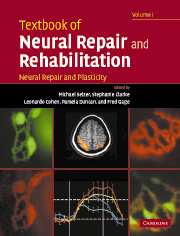Book contents
- Frontmatter
- Contents
- Contents (contents of Volume II)
- Preface
- Contributors (contributors of Volume I)
- Contributors (contributors of Volume II)
- Neural repair and rehabilitation: an introduction
- Section A Neural plasticity
- Section A1 Cellular and molecular mechanisms of neural plasticity
- Section A2 Functional plasticity in CNS system
- Section A3 Plasticity after injury to the CNS
- Section B1 Neural repair
- Section B2 Determinants of regeneration in the injured nervous system
- Section B3 Promotion of regeneration in the injured nervous system
- 25 Cell replacement in spinal cord injury
- 26 Dysfunction and recovery in demyelinated and dysmyelinated axons
- 27 Role of Schwann cells in peripheral nerve regeneration
- 28 Transplantation of Schwann cells and olfactory ensheathing cells to promote regeneration in the CNS
- 29 Trophic factor delivery by gene therapy
- 30 Assessment of sensorimotor function after spinal cord injury and repair
- Section B4 Translational research: application to human neural injury
- Index
29 - Trophic factor delivery by gene therapy
from Section B3 - Promotion of regeneration in the injured nervous system
Published online by Cambridge University Press: 05 March 2012
- Frontmatter
- Contents
- Contents (contents of Volume II)
- Preface
- Contributors (contributors of Volume I)
- Contributors (contributors of Volume II)
- Neural repair and rehabilitation: an introduction
- Section A Neural plasticity
- Section A1 Cellular and molecular mechanisms of neural plasticity
- Section A2 Functional plasticity in CNS system
- Section A3 Plasticity after injury to the CNS
- Section B1 Neural repair
- Section B2 Determinants of regeneration in the injured nervous system
- Section B3 Promotion of regeneration in the injured nervous system
- 25 Cell replacement in spinal cord injury
- 26 Dysfunction and recovery in demyelinated and dysmyelinated axons
- 27 Role of Schwann cells in peripheral nerve regeneration
- 28 Transplantation of Schwann cells and olfactory ensheathing cells to promote regeneration in the CNS
- 29 Trophic factor delivery by gene therapy
- 30 Assessment of sensorimotor function after spinal cord injury and repair
- Section B4 Translational research: application to human neural injury
- Index
Summary
Introduction
Neurotrophic factors were initially discovered as critical molecules in the growth and survival of developing neurons (Levi-Montalcini, 1966). They have subsequently been shown to enhance certain neuronal phenotypes, and to promote the survival and regeneration of damaged adult neurons. For these reasons, neurotrophic factors have tremendous therapeutic potential for a wide range of neurologic diseases. However, supplementation of neurotrophic factors can also have undesirable side effects. Therefore, successful clinical application depends on a thorough understanding of the endogenous functions and effects of neurotrophic factors. In addition, an efficient means of delivering appropriate concentrations of neurotrophic factors to target cells is required. Systemic therapy is not a viable option, given that neurotrophic factors generally have short half-lives, do not cross the blood–brain barrier, and have a wide range of effects on various targets. Intraventricular delivery also lacks anatomic and cellular specificity (Nutt et al., 2003). Intraparenchymal delivery (Gill et al., 2003) could overcome some of these limitations, although certain neurotrophic factors have limited diffusion from the injection site. Therefore, gene therapy represents the most promising means of providing continuous delivery of neurotrophic factors to specific anatomic and cellular targets.
A variety of gene therapy approaches have been considered for neurologic diseases. These include the replacement of missing neurotransmitters, augmenting the phenotypes of remaining neurons, promotion of neuronal regeneration, and prevention of further degeneration by delivering genes that impede cell death pathways.
Keywords
- Type
- Chapter
- Information
- Textbook of Neural Repair and Rehabilitation , pp. 532 - 547Publisher: Cambridge University PressPrint publication year: 2006

